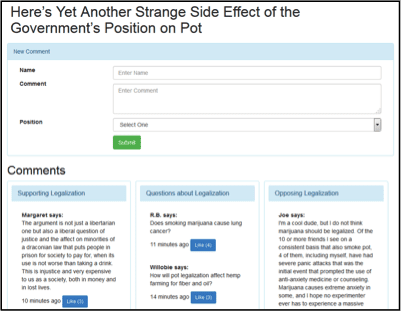
There are several benefits – and limits — to using a three-column comment section as opposed to using a traditional one-column section, according to a new report by the Center for Media Engagement.
The group’s research found that study participants rated a three-column comment section more favorably than the one-column comment section.
Research participants also were more likely to leave a comment in the three-column comment section than the one column. About one in five participants who had the ability to comment in this study chose to do so. In the one-column section, 17 percent of respondents left a comment. In the three-column comment section, 26 percent of participants left a comment.
Although most comment sections on national and local news websites are designed as one column of responses organized in a vertical or cascading manner, several news organizations, such as The New York Times and The Washington Post, have been experimenting with different formats.
“Most news organizations use comment sections on their websites, but only a small percentage of site visitors actually leave a comment,” said Dr. Talia Stroud, director of the Center for Media Engagement. “We wanted to see if changing the structure of the comments would make a difference in how many individuals left a comment and how people reacted to news topics.”
During the Center for Media Engagement’s research, two limits of the three-column structure emerged. First, although most of those leaving a comment in the three-column section selected the appropriate column for their comment, 5 percent left a comment in the incorrect column and 12 percent left a comment indicating little engagement (e.g. “NA”). Second, there were some indications that study participants were less engaged with the third, right-most column on the webpage. Those looking at the three-column structure “Liked” comments left in the third column less frequently than those in the one-column structure.
Other findings from the Center for Media Engagement’s research include:
- The three-column comment section was less familiar to participants than the one-column section.
- On average, participants spent one-and-a-half to two minutes with the comment sections. There was no difference in time spent with the one-column versus three-column comment section.
- The one- and three-column comment sections did not polarize people’s attitudes.
For its study, the Center for Media Engagement designed a working three-column comment section and a one-column comment section. The three-column section included comments categorized by whether they “favor,” “oppose,” or “ask questions about” marijuana legalization. In the one-column comment section, comments were displayed in the order they were posted.
“Based on our research, we think news outlets should pay attention to the structure of their websites, particularly their comment sections,” said Dr. Josh Scacco, research associate for the Center for Media Engagement. “Although we learned quite a bit about comment structure, we need to think more about how best to format the columns in a comment section.”
The Center for Media Engagement is planning to do more research on the design of comment sections in the future.
Click here to view the full report.

